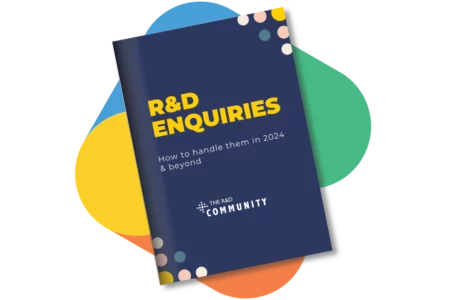As the R&D tax relief schemes have matured, it’s far more likely that for HMRC to undertake an enquiry, or ‘Compliance Check’ on a client’s R&D claim.
The first time you have to support a client through a R&D Compliance Check can be daunting. HMRC approach is built for a high volume of cases, and appears to be more automated, with templated schedule of information requests covering what seems to be every aspect of an R&D claim.
It can feel overwhelming, not just to your client, but also to you. It may seem that answering HMRC’s questions is more work even than preparing the original claim!
The consequences getting it wrong are considerable. In the worst-case scenario, your client could have their claim rejected, you may have to return your fee, and HMRC may apply considerable penalties if the claim is shown to be intentionally misleading or careless, and your relationship with your client could be irrevocably damaged.
Every enquiry will be different, which makes it difficult to know exactly how to handle them. To help you, we’ve prepared free guide on How to Handle an R&D Tax Relief Enquiry, to give you all the instructions you need for a strong enquiry defence. Whether it’s your very first time handling an enquiry, or you’ve been put through the wringer before, you’ll find something inside to help.
The very first thing to do, as we explain in the guide, is to make sure you and your client are prepared. Here’s what to do, and what to expect:
Stay calm, don’t panic
With enquiries becoming more commonplace, it is not a question of if a client will receive a compliance check on its R&D claim, but when. With HMRC’s volume compliance approach, we have seen very strong claims, with good supporting evidence, being challenged by HMRC.
Just you’ve had an enquiry, doesn’t mean you can’t defend the claim! Objectivity is key here. If the claim has been prepared in accordance with the guidelines, the scope of R&D defined and project activities mapped to qualifying activities then it should be relatively easy to provide the “right” evidence to amount to a strong defence.
But it’s completely normal if you’re not feeling so confident, especially if you’re tackling this for the first time. Perhaps you had a few unanswered questions about the evidence that was presented to support the projects. In those cases, you may wish to look externally for a second opinion on the strengths and weaknesses of the claim, or for ideas on where to collect more evidence to strengthen your defence.
Communicating with HMRC
During initial stages of an enquiry, it’s pretty impossible to speak directly with caseworkers concerning any specifics. This is doubly true where those claims are dealt with by the Individual and Small Business Compliance (ISBC) department.
Related: Enquiry Letters – what to expect from different HMRC departments
Enquiries typically progress through a series of letters and responses between HMRC and your client. Each letter or request for information will come with a deadline attached. If you need an extension, these are usually granted, but often HMRC will try to resolve the Compliance Check as soon as possible.
Occasionally you can arrange a phone or video conversation with HMRC to discuss the case, but usually only after the compliance check has involved several rounds.
All this means the time burden of defending an enquiry is often significant. It’s rarely a simple task to put together the argument to rebut HMRC’s position and to present evidence with clarity. Doing so on a tight turnaround makes it doubly challenging.
Educate your client
Perhaps the most important part of any enquiry is making sure you and your client are on the same page. They need to understand the approach you are proposing to take with HMRC and why.
So start by refreshing their understanding of what eligibility under the scheme looks like and how it applies to their projects. You may also want to refer your client to HMRC’s Guidance for Compliance concerning R&D Tax relief – it has some useful examples. With the right background, they can then provide you with the right kind of evidence on their projects that would support their claim.
You should also make your client aware of timelines. Compliance checks are rarely quick, and typically two or three rounds are required before HMRC will make a decision on the claim. There’s a lot of ‘hurry up and wait’ as you work to prepare a response within the deadline, but then have to wait weeks to hear anything back from HMRC. Typically, it takes 6 months or more.
It’s also essential to explain to your client when and why HMRC may raise penalties.
Your approach to defending the enquiry
Finally, to guide your own approach, remember that the enquiry is not a legal argument. Yes, the quality of evidence really matters, and being able to refer this evidence back to the DSIT guidelines is essential. But there is no third party mediating – your goal is to bring them around to your side, not to try and “win” at their expense.
It’s important to be helpful, communicative and collaborate with HMRC. Your aim at every stage is to offer clarity to help HMRC understand why the project should qualify. It may not always work, but it’s much less risky than being unhelpful and combative.
Bear in mind that yours and your client’s behaviour will be taken into account if HMRC has to consider levying any penalties at the end of the process due to an inaccuracy in the original claim.
Related: An Insider’s Guide to R&D Tax Relief Enquiries
Support for R&D advisors to defend enquiries
To help you through these preparations, and through the defence itself, download our free guide How to Handle an R&D Enquiry. It covers all these steps in more detail and is a useful reference for any future enquiries that may come up.
If you’d like more hands-on support with a client’s claim or enquiry, you can read about our Enquiry Defence service.





